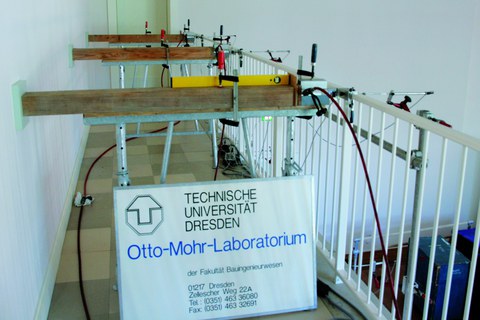Static load test of a balustrade to receive approval for use of the building section for public events
Table of contents
Project data
| Titel | Title Belastungstest eines Geländers zur Freigabe eines Gebäudeteils für öffentliche Veranstaltungen | Static load test of a balustrade to receive approval for use of the building section for public events Auftraggeber | Client Festspielhaus Hellerau, Liegenschaftsamt Dresden Zeitraum | Period 08.2009 Leiter | Project Manager Dr.-Ing. Torsten Hampel Durchführung | Realisation Ludwig Beier, Dr.-Ing. Torsten Hampel, Tilo Jänke, Dr.-Ing. Silke Scheerer, Heiko Wachtel, Hans-Peter Werneke |
Report in the yearbook 2009
Static Load Test of a Balustrade

Experimental set-up during the load test
An elevated area surrounded by a balustrade at the Festspielhaus Hellerau in Dresden is to be used for public events. The current level of protection provided against falls by the existing balustrade does not meet the static load requirements specified in the German code, DIN 1055-3. Evidence that the balustrade meets the required load-bearing capacity will be provided from the results of a static in situ load test.
Test Set-up
According to national standards, a balustrade must be able to resist a specific constant line load. In this experiment, the railing was charged with a number of equivalent point loads since an uniformly distributed line load is difficult to simulate. Three contiguous fields were loaded in such a manner so that the continuous effect of the entire balustrade construction could be taken into consideration. The measuring equipment was dimensioned and the stress regime was established based on a rough calculation.
The load was set using synchronised hydraulic jacks located at three load points, and the load level was monitored by load cells. At the same time, deformations of the three loaded balusters were each monitored at two specific locations: at the base and at the point of load application. Since the mechanical properties of railings and balustrade fixings were unknown, the point of transition from elastic to plastic deformation of any of the posts was defined as criterion for terminating the stress test. The real-time computer display of precisely obtained experimental variable measurements made it possible to identify the change from elastic to plastic material behavior.
Results
Initial signs of plastic deformation appeared at a load of approximately 3 × 1.6 kN; and the experiment was then stopped. At this point, the deflection of the balustrade was slightly higher than the predicted value. The railing, however, did not show any signs of plastic deformation either during or after the experiment. Closer exami nation of the bases revealed the plasticization of the small anchors embedded in the floor. The degree of restraint of the posts had fallen significantly, and the deformation of the handrail increased disproportionately.
Based on this finding, several possibilities to strengthen the balustrade were identified that are now included in the structure’s renovation concept.
